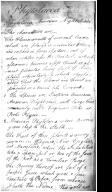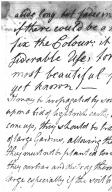[ Phytolacca, American Nightshade ] Dr. William James Almon
Date: Circa 1735.
Source:
Manuscript Notebook of Dr. William James Almon
Institution: Nova Scotia Archives
| Source Origin: Almon Family Fonds
| Reference: MG 1 / Microfilm Reel 10,045
A description of American and Mexican nightshade, including the latter's usefulness as a purgative, pp. 22-23. Though largely identical to an entry of the same title that appears under "Ph" in The Gardener's Dictionary Vol. 2 (London, 1735) the Almon text also includes details that do not appear in the abridged publication; it is thus more likely transcribed from the original folio by Philip Miller. Identifying Miller in the later version as "Gardener to the Worshipful Company of Apothecaries, at their Botanick-Garden, in Chelsea," the Dictionary's subtitle points also to "Methods of Cultivating and Improving" the "Physick Garden" as well as those of "Kitchen, Fruit and Flower."
Phytolacca
Phytolacca, American Nightshade.
The characters are; -
The Flowers consists of several leaves,
which are placed in a circular order,
and expand in form of a Rose; out of
whose centre rises the Pointal, which
afterward becomes a soft Fruit, or al=
=most globular berry full of seeds,
placed orbicularly: to which should be
added. That the Flowers and Fruit are
Produced on a branch like Currans. _
1.The Species are Phytolacca Americana,
American Nightshade, with large Fruit,
Commonly call’d Virginian Poke or
Porke Physic. -
2. Mexican Phytolacca whose Berries
grow close to the Stalk. -
The first of these plants is verry
common in Virginia, New England,
and Maryland, where the Inhabitants
take a spoon-ful or two of the Juice
of the Root as a Familiar Purge.
The Berries thereof are ful of a
purple Juice which gives a fine
Tincture to paper, from whence
it hath the Name: this will not
abide long but fades in short time therefore
if there could be a Method found to
fix the Colour: it might be of con=
siderable Use, for it is one of the
most beautiful purple Dyes
yet known. --
It may be propagated by sowing the seeds in the spring
upon a bed of light rich earth; and when the plants
come up, they should be transplanted into the borders
of large Gardens, allowing them space for to grow; for
they must not be planted too near other plants, least
they overbear and destroy them; for they grow to be very
large especially if the soil be good. ~
Download: Transcription | Images

